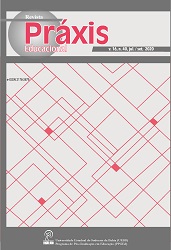THE LUDIC DAILY LIFE OF THE SHOESHINE BOYS FROM SÃO PAULO
DOI:
https://doi.org/10.22481/praxisedu.v16i40.6888Keywords:
Everyday History, History of São Paulo City, Shoeshine boyAbstract
Since the nineteenth century, shoeshine boys have occupied the streets of São Paulo for work and also for fun, playing gamesbetween one client and another or after the work was done. At the beginning of the twentieth century, the boys used public spaces in the city, such as Praça da Sé and Largo do Correio, dealing daily with the repression. Throughout the forties, the game of marbles lost space for another form of fun, music, transforming their own work instruments into musical instruments. Today, shoeshine boys still persist in the downtown area and in more distant neighborhoods, such as the Congonhas airport region, and continue to color the busy daily life with play and music. Based on research in periodicals, photographs and police documents, the article identifies and describes how it happened in the past and how the use of public spaces by the shoeshine boys in São Paulo still occurs today, as well as their amusements and strategies to survive in the context of the city.
Downloads
References
CHARTIER, Roger. A História Cultural: entre práticas e representações. 2ª Edição. Lisboa: Difel, 2002.
COMO vai passar o carnaval? Jornal Folha da Noite. 2a Edição. São Paulo. 25 de fevereiro de 1933. Capa.
DESABAFOS de Juca Pato. Jornal Folha da Manhã. São Paulo, 29 de janeiro de 1927. p.3
DIAS, Maria Odila Leite da Silva. Quotidiano e Poder em São Paulo no Século XIX. São Paulo: Brasiliense, 1995.
FAUSTO, Boris Crime e Cotidiano. A criminalidade em São Paulo (1880-1924). São Paulo: Brasiliense, 1984.
FREHSE, Fraya. Ô da Rua! O Transeunte e o Advento da Modernidade em São Paulo. São Paulo: Editora da Universidade de São Paulo, 2011.
FREYRE, Gilberto. Sobrados e Mucambos. Rio de Janeiro, José Olympio Editora, 3a Edição, 1961. [1a ed. 1936].
HADFIELD, William. Brazil and The River Plate in 1868. Londres: Bates, Hendy and Co. 1869.
LEMOS, Túlio de. O Canto dos Engraxates Paulistanos. Revista Planalto, São Paulo, ano 1, número 8, 1 de outubro de 1941.
MARTINS, Antonio Egydio. São Paulo Antigo: 1554 a 1910. São Paulo: Paz e Terra, 2003.
MORAES, José Geraldo Vinci de. Metrópole em Sinfonia: historia, cultura e música popular na São Paulo dos anos 30. São Paulo: Estação Liberdade/ Fapesp, 2000.
MORAES, José Geraldo Vinci de. Sonoridades Paulistanas. Final do século XIX ao início do século XX. Rio de Janeiro: Funarte, 1995. Pp.138 e 139.
MORAES, José Geraldo Vinci de e MACHADO, Cacá. Música em Conserva. Revista Auditório. São Paulo. N.1. P. 163 – 183, 2011. P.173.
MORAES, José Geraldo Vinci de. “Modulações e Novos Ritmos na Oficina da História”. Revista Galega de Cooperación Científica Iberoamericana. Espanha. N.11, 2005. P. 51.
NOTÍCIAS diversas - Câmara Municipal. Jornal O Estado de São Paulo. São Paulo 25 de dezembro de 1904, p.3
OLIVEIRA. Roberto de. Os meninos de Congonhas. Jornal Folha de São Paulo. São Paulo. 15 de setembro de 2013. Caderno Cotidiano, p.10.
PORTELA, Fernando. Bonde o saudoso paulistano. São Paulo: Editora Terceiro Nome, 2006.
QUEIXAS e Reclamações. Jornal O Estado de São Paulo. São Paulo, 13 de julho de 1916. p.4.
QUEIXAS e Reclamações. Jornal O Estado de São Paulo. São Paulo, 1 de novembro de 1916, p. 5.
SIMSON, Olga Rodrigues de Moraes. Carnaval em Branco e Negro: Carnaval Popular Paulistano: 1914-1988. Campinas: Editora da Unicamp; São Paulo: Editora da Universidade de São Paulo; Imprensa Oficial do Estado de São Paulo, 2007.
VAI graxa? Jornal Folha de São Paulo. São Paulo.15 de setembro de 2013. Capa
TOTA, Antonio Pedro. “Rádio e modernidade em São Paulo”. História da Cidade de São Paulo, v.3: a cidade na primeira metade do Século XX. Paula Porta (org). São Paulo: Paz e Terra, 2004.
Downloads
Published
Issue
Section
License
Você é livre para:
Compartilhar - copia e redistribui o material em qualquer meio ou formato; Adapte - remixe, transforme e construa a partir do material para qualquer propósito, mesmo comercialmente. Esta licença é aceitável para Obras Culturais Livres. O licenciante não pode revogar essas liberdades, desde que você siga os termos da licença.
Sob os seguintes termos:
Atribuição - você deve dar o crédito apropriado, fornecer um link para a licença e indicar se alguma alteração foi feita. Você pode fazer isso de qualquer maneira razoável, mas não de uma forma que sugira que você ou seu uso seja aprovado pelo licenciante.
Não há restrições adicionais - Você não pode aplicar termos legais ou medidas tecnológicas que restrinjam legalmente outros para fazer qualquer uso permitido pela licença.












